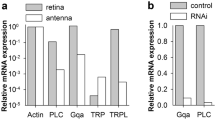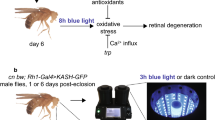Summary
ThenorpA H44 phototransduction mutant ofDrosophila melanogaster, an allele that, on eclosion, does not exhibit a receptor potential was found, at later ages, to undergo light and temperature dependent degeneration of its photoreceptors as well as decreases in rhodopsin concentration. Pseudopupil measurements and light and electron microscopy were used to monitor the structure of the photoreceptors. WhennorpA H44 flies were maintained exclusively in the dark, no changes in structure or rhodopsin concentration were observed. When maintained on a 12 h light-12 h dark cycle, structural changes were first observed at 6 days of age for flies maintained at 24 °C or at 12 days of age for flies maintained at 19 °C. When the light-dark cycle was initiated after 10 days in the dark there was a more rapid loss of rhodopsin concentration and pseudopupil. The data suggest that even in the dark, although no obvious changes in structure or rhodopsin concentration were observed, certain processes that support these components had been affected.NorpA P12, an allele that exhibits small receptor potential amplitudes, also displayed age- and light-dependent photoreceptor degeneration and decreases in rhodopsin concentration, whereas no degeneration or decreases in rhodopsin were observed innorpA P16, an allele that exhibits receptor potential amplitudes similar to those of wild-type. The data suggest that the processes that affect phototransduction, such as the phosphatidylinositol cycle, have a long-term role in the maintenance of rhodopsin concentration and photoreceptor integrity.
Similar content being viewed by others
Abbreviations
- PI :
-
phosphatidylinositol
References
Berridge MJ, Irvine RF (1984) Inositol trisphosphate, a novel second messenger in cellular signal transduction. Nature 312:315–321
Brammer JD, Stein PJ, Anderson RA (1978) Effect of light and dark adaptation upon the rhabdom in the compound eye of the mosquito. J Exp Zool 206:151–156
Franceschini N (1972) Pupil and pseudopupil in the compound eye ofDrosophila. In: Wehner R (ed) Information processing in the visual systems of arthropods. Springer, Berlin Heidelberg New York, pp 75–82
Harris WA, Stark WS (1977) Hereditary retinal degeneration inDrosophila melanogaster: A mutant defect associated with the phototransduction process. J Gen Physiol 69:261–291
Inoue H, Yoshioka T, Hotta Y (1985) A genetic study of inositol trisphosphate involvement in phototransduction usingDrosophila mutants. Biochem Biophys Res Commun 132:513–519
Kirschfeld K, Franceschini N (1968) Optische Eigenschaften der Ommatidien im Komplexauge vonMusca. Kybernetik 5:47–52
Ostroy SE (1978) Characteristics ofDrosophila rhodopsin in wild-type andnorpA vision transduction mutants. J Gen Physiol 72:717–732
Pak WL (1979) Study of photoreceptor function usingDrosophila mutants. In: Breakfield X (ed) Neurogenetics: Genetic approaches to the nervous system. Elsevier/North Holland, New York, pp 67–99
Pak WL, Ostroy SE, Deland MC, Wu C-F (1976) Photoreceptor mutant of Drosophila: Is protein involved in intermediate steps of phototransduction? Science 194:956–959
Williams MA, Gherson J, Fisher EJ, Pinto EH (1985) Synaptic lamellae of the photoreceptors of pearl and wild-type mice. Invest Ophthalmol Visual Sci 26:992–1001
Wilson MJ, Ostroy SE (1987) Studies of theDrosophila norpA phototransduction mutant. I. Electrophysiological changes and the offsetting effect of light. J Comp Physiol A 161: 785–791
Yoshioka T, Inoue H, Hotta Y (1983) Defective phospholipid metabolism in the retinular cell membrane ofnorpA (no receptor potential) visual transduction mutants ofDrosophila. Biochem Biophys Res Commun 111:567–573
Yoshioka T, Inoue H, Hotta Y (1984) Absence of diglyceride kinase activity in the photoreceptor cells ofDrosophila mutants. Biochem Biophys Res Commun 119:389–395
Yoshioka T, Inoue H, Hotta Y (1985) Absence of phosphatidylinositol phosphodiesterase in the head of aDrosophila visual mutant,norpA (no receptor potential A). J Biochem (Jpn) 97:1251–1254
Author information
Authors and Affiliations
Rights and permissions
About this article
Cite this article
Meyertholen, E.P., Stein, P.J., Williams, M.A. et al. Studies of theDrosophila norpA phototransduction mutant. J. Comp. Physiol. 161, 793–798 (1987). https://doi.org/10.1007/BF00610221
Accepted:
Issue Date:
DOI: https://doi.org/10.1007/BF00610221




